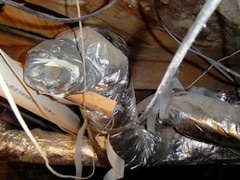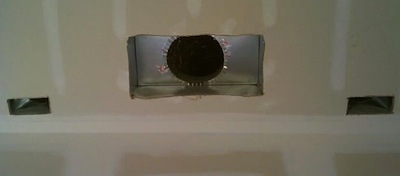To Heck with Duct Design! Let’s Just Throw the Vents Anywhere

You’d think with all the articles I’ve written about bad duct installations that it’d be hard to find more to write about here. After all, I’ve told you about stumpy (photo left) and panned joist return ducts and what may be the worst location ever for ducts and the ductopus and…
There just seems to be no end, though. The guys who install duct systems in the field are a creative lot, ya know. After writing my article for Monday on supply duct trunk lines that can cause the air to go backwards, I received the photo below from Brad Brinke of ProCraft Inspections. Brad is one of my former HERS rater class students from when I was teaching at Southface, and he was touring some new homes under construction this week when he saw this horror show.

Can you see what the problem is here? If you’re not familiar with duct systems, it may not be obvious, but the big vent you see in the middle is a return, which pulls air from the house back to the furnace or air conditioner to be heated or cooled again. Those two smaller vents on the sides are supply vents, which push the conditioned air back into the the house.
Do you think this room is going to get a lot of mixing of the air from the supply vents with the air that’s already in the room? Or will much of the newly conditioned air find its way quickly back to that big, honking return vent that’s only a foot or so away? Even worse, this configuration is in a vaulted ceiling about 12′ off the floor, meaning that the room below may stay uncomfortable most of the time, especially in winter when the warm air never falls down to where the people are.
If you think your HVAC contractor is going to do it right just because they’ve been in business a long time, I’d like to suggest that you request full HVAC design to improve your chances of getting a good system—including the ducts—installed. Even better, have a third party (like Energy Vanguard!) do the HVAC design.
This Post Has 12 Comments
Comments are closed.

This can be “fixed”
This can be “fixed” by using commercial grade registers that have a long throw. Of course it would have been better to to design it right to begin with…
Bob:
Bob: Thanks for you comment! I’m glad you put the word “fixed” in quotation marks because it’s not a real solution. Yes, it will help some, but I imagine that a duct system with a problem like this also has static pressure and air flow problems. If those supply vents aren’t getting much air and it’s coming out at low velocity, changing the registers won’t help a lot, especially in the winter, when the air wants to hang out by the ceiling anyway.
I have upgraded all of my
I have upgraded all of my residential “4-way” registers to the commercial grade stuff. The commercial grade models allow you to direct airflow much more precisely. It’s not a cheap upgrade but it pays for itself in increased comfort and can help with warm air settling at the ceiling. Running the furnace blower at it’s highest setting helps a lot with the “throw” also. These combined have helped with winter comfort in my house where the supplies and returns are both in the 10′ ceiling. If it was my design the returns would be low (better for heating) with supplies being high (better for cooling).
Bob: Good
Bob: Good registers can certainly make up for other deficiencies, but as you say, proper placement of the vents (ACCA Manual T) is better.
It is my understanding this
It is my understanding this type of arrangement is innocuous provided the supply registers have good throw. I am not HVAC professional, but an interested enough amateur to own the the ACCA Manual D book. This subject has been discussed at great length on the HVAC-Talk board among pros, with the initial post being the allegation you can greatly improve comfort having both high and low returns, switching from one to the other depending on the season. The “pro” advocates are those with less professional credentials. The “con” argument, supported by Manual D is return location mostly Just Does Not Matter. Supplies are delivering high speed air and returns are pulling quiet air. In this case they observe the purpose of register selection (ACCA Manual T) is to ensure good throw and room air mixing, which makes the return location far less relevant. While the picture looks goofy and I would not want it myself, the pro lesson is if there are comfort or efficiency issues it will be due to other causes.
Big words like throw and
Big words like throw and velocity. Your going to put the AC installers to sleep man talking a foreign language.
The other missing bit of
The other missing bit of information here is the climate it’s designed for. If this is a straight AC system it could work quite well since the supply air is so cold and dense it would sink like a rock, but in a heating mode with wimpy airflow it’ll short-circuit for sure. Duct design is critical to acceptable performance and architects need to think about how duct are going to be fitted in the house or building. So often theres no more thought to the HVAC system than a square and a circle in the garage marked Furn and WH. Beams and joist hangers are the nemesis of the HVAC contractor and often there’s no place left to put the ductwork other than the attic and crawlspace. Thankfully we have closed attic and closed crawlspace provisions in our residential code now so the ducts can be installed inside the conditioned envelope.
Very nice post. I wish there
Very nice post. I wish there were more like it and that homeowners would focus more on proper sizing of HVAC systems and ducts using Manuals J and D than installing solar energy. I think we’d be doing more for the environment, use less energy and save money. See http://www.millennialliving.com/content/sizing-your-hvac-system-go-green-and-save-energy
M. Johnson
M. Johnson: Good throw depends on static pressure and face velocity. If the air comes out slowly, it’s not going far.
Chris C.: Yes, there is that danger, I suppose.
Mac S.: You’re right. I thought I’d included the location in the article but didn’t. This is in Virginia, with about 3500 heating degree days, so there is a significant heating load.
Tom: Thanks. The article you provided the URL for looks like a good overview.
M Johnson, no matter what the
M Johnson, no matter what the more credentialed folks over at HVAC-Talk might have said, separating supplies and returns from one another *will* improve mixing. Likewise, the configuration shown above *will* lead to reduced mixing. Whether or not there would be any direct feedback depends on face velocity, as you noted in your post.
One of the biggest stumbling blocks for even the most diligent mechanical contractor is how to maintain face velocity in homes with a design airflow of less than, say, 0.3 cfm per square foot. The good folks who wrote Manual D (and T) never envisioned homes that would only require 1200 or 1500 sf per ton, or even more. I know. I was on the committee for the last revision.
Fortunately, as it turns out, the more efficient the envelope, the less important face velocity becomes, mostly because the worst-case temperature gradients grow smaller with the load. And with properly sized equipment, cycle times will be longer, helping with air mixing. By the same token, return placement become more important.
This photo says nothing about
This photo says nothing about the context of this system design or intent. How high is this gable? Is this air coming from a 2nd floor attic system serving the top portion of a 23′ high vaulted Great Room, supplementing the 1st floor system that is delivering conditioned air to the occupied level of that very high room? If so then it is a fantastic addition to the comfort of that room. If you want to criticize a photo, and berate the designer, and even implicate an entire workforce of a particular industry/trade, then it would be better received if it was done in a fashion that demonstrates your acuity for the topic by presenting specific data and context. You could simply have said, “Spacing return and supply openings further apart, increases the ratio of unconditioned air to conditioned air returning to the airhandling equipment.”
@Charlie, had Allison written
@Charlie, had Allison written as you describe, he would have sounded too much like me, and as such, would undoubtedly have put half his readers to sleep.